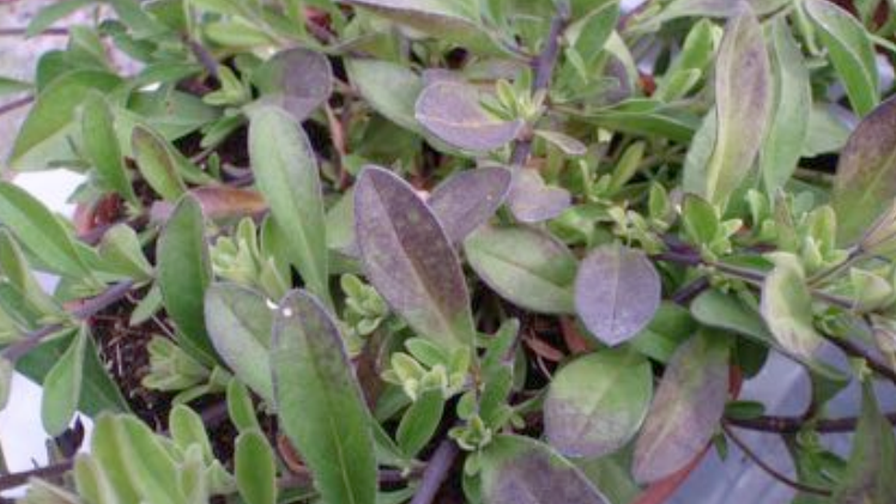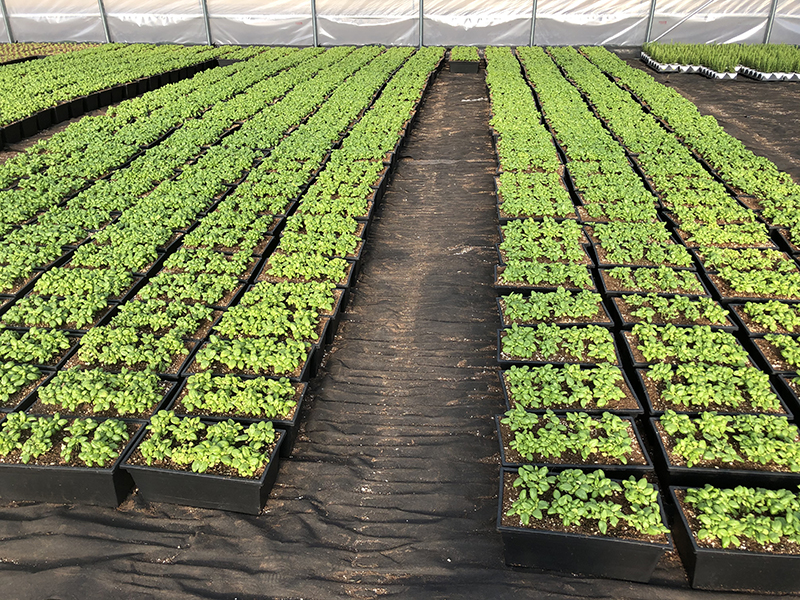Dealing With Petunia Purpling Problems

Lower purple leaf discoloration resulting from phosphorus deficiency and cold growing. Photo: Brian Whipker
From rooting to finishing, there are a wide range of reasons why petunias might display purple discoloration. However, the location of occurrence and the stage can help diagnose why the discoloration is occurring.
In a recent eGRO alert, Patrick Veazie and Dr. Brian Whipker of North Carolina State University explain that anthocyanins are secondary metabolites in plants that are responsible for the red and purple colors. However, anthocyanin concentrations can be impacted by many factors including light quality, temperature, nutrient deficiency, carbohydrate status, root rot, over watering, and drought. When an increase in anthocyanin concentration is observed, growers must determine the likely culprit for the change in leaf color.
LED Blue Radiation
Propagation for spring bedding plants occurs during the darkest days of the year from both a light quality and quantity perspective. As a result, many growers utilize supplemental lighting to promote plant growth. Growers have a wide range of lighting spectrum choices ranging from narrow bands (specific wavelengths of light) such as blue or red radiation or broadband (a wide range of wavelengths) which generally appear as white. When rooting under blue and red LED, growers may observe a purple discoloration of the foliage. However, one may ask why cuttings rooted under traditional lights such as high-pressure sodium (HPS) lights generally exhibit less severe coloration.
LEDs are generally more efficient in light production compared to HPS lamps. This results in less ambient heat being given off by the light fixtures. As a result, growers should increase their root zone temperatures when utilizing LEDs to prevent purple discoloration from occurring. While the purple discoloration on rooted cuttings at the end of the propagation stage once the cutting is transplanted and warmer temperatures are received the plant will grow out of the discoloration.
Nutrient Deficiencies
Nutrient deficiencies can often impact foliage color; phosphorus (P) is the most commonly attributed deficiency to result in lower leaf purpling. This is most commonly observed in combination with cold or wet growing conditions. In the southeast with warmer climate conditions P deficiency will often manifest as overall pale green lower foliage and olive spotting patterns. However, magnesium (Mg) can also result in lower leaf purpling. While Mg, deficiency is commonly attributed as interveinal chlorosis of the lower foliage, in cold growing conditions lower leaf purple discoloration has been observed on petunia when growers utilize a fertilizer such as 20-10-20 (N-P2O5-K2O), a fertilizer that does not supply calcium or Mg, and also rely on the Mg from the dolomitic limestone during spring bedding plant production. Changing to a 17-4-17 Cal Mag fertilizer at a similar rate will supply adequate Mg for optimal petunia growth or an application of Epsom salt of 2 pounds per 100 gallons will prevent the advancement of Mg deficiency. Both P and Mg are mobile elements within the plant and will be translocated from the lower foliage (sources) to the newly developing part of the plant (sinks) such as flowers or new expanding foliage. Growers should conduct foliar tissue analysis to confirm nutrient deficiencies.
Read the complete eGRO alert here.









